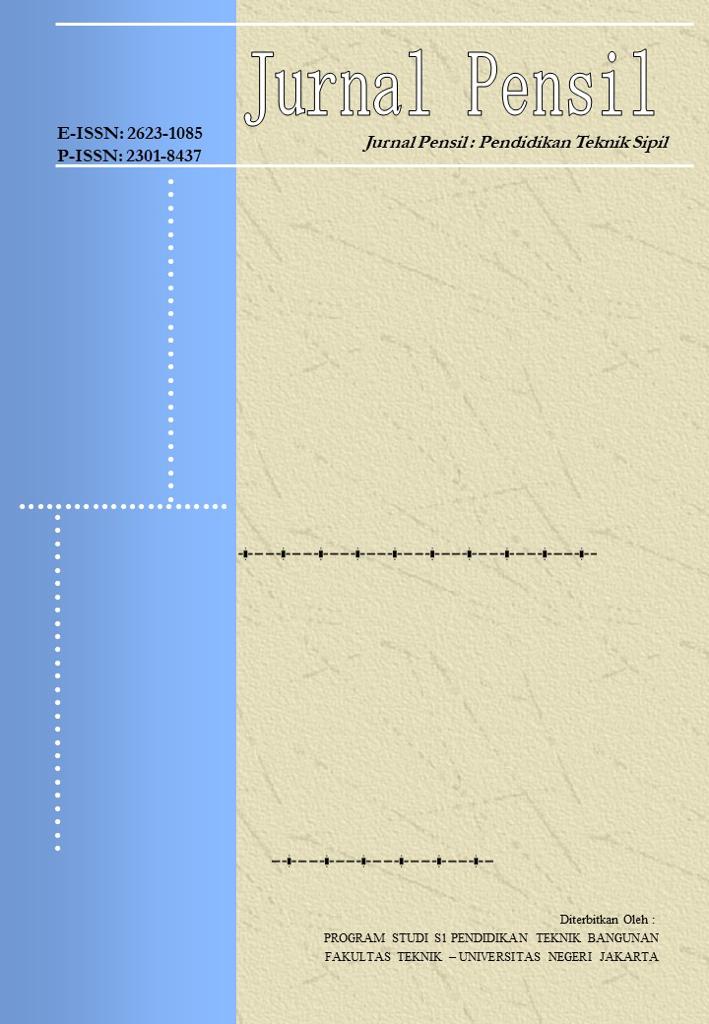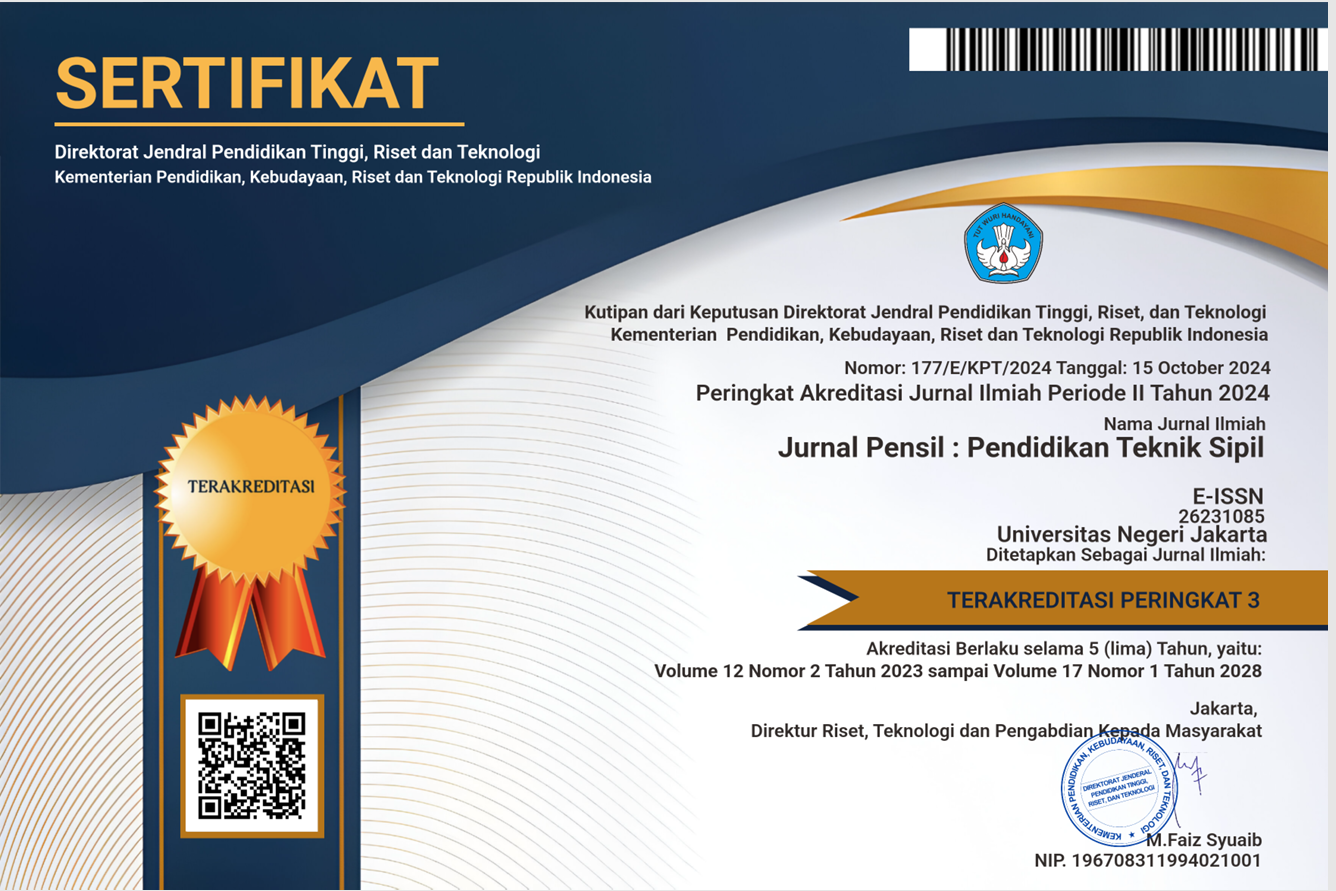EVALUATION OF THE STRENGTH CHARACTERISTIC OF SOIL STABILIZED WITH FLY ASH
DOI:
https://doi.org/10.21009/jpensil.v12i3.37489Keywords:
Solid Waste, Circular Economy, Fly Ash, Soil Stabilization, Unconfined Compressive StrengthAbstract
High domestic consumption of coal, especially in energy sector, has raised concerns on several environmental issues in Indonesia. Large amount of coal combustion product in the form of solid waste, such as fly ash resulting from coal power plant production causes problems in its disposal since its necessity of land occupancy. Over the last decade, many researchers have put effort to solve this disposal concerns by utilizing these materials for various purposes, such as construction materials as part of circular economy. This paper presents the utilization of fly ash for soil stabilization in Surabaya. Firstly, the index properties of soil samples were determined through a series of laboratory soil test including specific gravity, unit weight, moisture content, sieve analysis and Atterberg’s limit tests. Subsequently, standard proctor test was conducted to obtain the maximum dry density and optimum moisture content of the soil samples. Using those parameters, four types of soil stabilized with fly ash samples were prepared with fly ash content based on weight of soil as follows: 0%, 5%, 10%, and 15%. Finally, unconfined compression tests were performed with cylindrical soil samples to assess the unconfined compressive strength of those samples. The results indicate that soil with fly ash content of 10% showing the highest unconfined compressive strength compared to the other variations of 0.90 kg/cm2.
References
Ahmad, S., Ashraf Husain, S. M., & Ahmad, S. (2015). Stabilization of Low Shear Strength Soil by using Fly Ash. IOSR Journal of Mechanical and Civil Engineering, 12(4), 2278–1684. https://doi.org/10.9790/1684-12463336
Alterary, S. S., & Marei, N. H. (2021). Fly ash properties, characterization, and applications: A review. Journal of King Saud University - Science, 33(6), 101536. https://doi.org/10.1016/j.jksus.2021.101536
Ambikakumari Sanalkumar, K. U., Lahoti, M., & Yang, E.-H. (2019). Investigating the potential reactivity of fly ash for geopolymerization. Construction and Building Materials, 225, 283–291. https://doi.org/https://doi.org/10.1016/j.conbuildmat.2019.07.140
Andavan, S., & Pagadala, V. K. (2020a). A study on soil stabilization by addition of fly ash and lime. Materials Today: Proceedings, 22, 1125–1129. https://doi.org/10.1016/j.matpr.2019.11.323
Andavan, S., & Pagadala, V. K. (2020b). Experimental study on addition of lime and fly ash for the soil stabilization. Materials Today: Proceedings, 22, 1065–1069. https://doi.org/10.1016/j.matpr.2019.11.300
Badan geologi. (2019). Atlas Sebaran Tanah Lunak Indonesia.
Besari, D. A. A., Anggara, F., Rosita, W., & Petrus, H. T. B. M. (2022). Characterization and mode of occurrence of rare earth elements and yttrium in fly and bottom ash from coal-fired power plants in Java, Indonesia. International Journal of Coal Science and Technology, 9(1). https://doi.org/10.1007/s40789-022-00476-2
Bhajantri, V., Krishna, P., & Jambagi, S. (2018). A brief review on fly ash and its use in surface engineering. AIP Conference Proceedings, 1943(April). https://doi.org/10.1063/1.5029604
Bhatt, A., Priyadarshini, S., Acharath Mohanakrishnan, A., Abri, A., Sattler, M., & Techapaphawit, S. (2019a). Physical, chemical, and geotechnical properties of coal fly ash: A global review. Case Studies in Construction Materials, 11, e00263. https://doi.org/10.1016/j.cscm.2019.e00263
Bhatt, A., Priyadarshini, S., Acharath Mohanakrishnan, A., Abri, A., Sattler, M., & Techapaphawit, S. (2019b). Physical, chemical, and geotechnical properties of coal fly ash: A global review. Case Studies in Construction Materials, 11, e00263. https://doi.org/10.1016/j.cscm.2019.e00263
Ghosh, A., & Subbarao, C. (2007). Strength Characteristics of Class F Fly Ash Modified with Lime and Gypsum. Journal of Geotechnical and Geoenvironmental Engineering, 133(7), 757–766. https://doi.org/10.1061/(asce)1090-0241(2007)133:7(757)
Grace, M. A., Clifford, E., & Healy, M. G. (2016). The potential for the use of waste products from a variety of sectors in water treatment processes. Journal of Cleaner Production, 137, 788–802. https://doi.org/https://doi.org/10.1016/j.jclepro.2016.07.113
Hou, P. K., Kawashima, S., Wang, K. J., Corr, D. J., Qian, J. S., & Shah, S. P. (2013). Effects of colloidal nanosilica on rheological and mechanical properties of fly ash-cement mortar. Cement and Concrete Composites, 35(1), 12–22. https://doi.org/10.1016/j.cemconcomp.2012.08.027
Islam, S., Hoque, N., Uddin, M., & Chowdhury, M. (2018). Strength development in clay soil stabilized with fly ash. Jordan Journal of Civil Engineering, 12(2), 188–201.
Kalita, T., Saikia, A., & Das, B. (2017). Effect of Fly-ash on Strength Behavior of Clayey Soil. International Research Journal of Engineering and Technology(IRJET), 4(7), 5–7.
Karami, H., Pooni, J., Robert, D., Costa, S., Li, J., & Setunge, S. (2021). Use of secondary additives in fly ash based soil stabilization for soft subgrades. Transportation Geotechnics, 29(January), 100585. https://doi.org/10.1016/j.trgeo.2021.100585
Kumar, P. G., & Harika, S. (2020). Stabilization of expansive subgrade soil by using fly ash. Materials Today: Proceedings, 45, 6558–6562. https://doi.org/10.1016/j.matpr.2020.11.469
Mathapati, M., Amate, K., Prasad, C. D., Jayavardhana, M. L., & Raju, T. H. (2021). A review on fly ash utilization. Materials Today: Proceedings, 50, 1535–1540. https://doi.org/10.1016/j.matpr.2021.09.106
Munda, J., Padhi, J., & Mohanty, S. (2022). Investigation on performance of expansive soil stabilized with fly ash and nano-SiO2. Materials Today: Proceedings, 67, 1268–1275. https://doi.org/10.1016/j.matpr.2022.08.524
Nath, B. D., Molla, Md. K. A., & Sarkar, G. (2017). Study on Strength Behavior of Organic Soil Stabilized with Fly Ash. International Scholarly Research Notices, 2017, 1–6. https://doi.org/10.1155/2017/5786541
Nordmark, D., Vestin, J., Hansson, L., & Kumpiene, J. (2022). Long-term evaluation of geotechnical and environmental properties of ash-stabilised road. Journal of Environmental Management, 318(June). https://doi.org/10.1016/j.jenvman.2022.115504
Ozdemir, M. A. (2016). Improvement in Bearing Capacity of a Soft Soil by Addition of Fly Ash. Procedia Engineering, 143(Ictg), 498–505. https://doi.org/10.1016/j.proeng.2016.06.063
Permana, A. M., & Rahardjo, P. P. (2022). The site characterization of central jakarta soft soil using CPTu and laboratory test. Indonesian Geotechnical Journal, 1(1), 25–40. https://doi.org/10.56144/igj.v1i1.6
Petrus, H. T. B. M., Olvianas, M., Suprapta, W., Setiawan, F. A., Prasetya, A., Sutijan, & Anggara, F. (2020). Cenospheres characterization from Indonesian coal-fired power plant fly ash and their potential utilization. Journal of Environmental Chemical Engineering, 8(5), 104116. https://doi.org/10.1016/j.jece.2020.104116
Ram, A. K., & Mohanty, S. (2022). State of the art review on physiochemical and engineering characteristics of fly ash and its applications. International Journal of Coal Science and Technology, 9(1). https://doi.org/10.1007/s40789-022-00472-6
Renjith, R., Robert, D., Setunge, S., Costa, S., & Mohajerani, A. (2021). Optimization of fly ash based soil stabilization using secondary admixtures for sustainable road construction. Journal of Cleaner Production, 294, 126264. https://doi.org/10.1016/j.jclepro.2021.126264
Risdanareni, P., Puspitasari, P., & Januarti Jaya, E. (2017). Chemical and Physical Characterization of Fly Ash as Geopolymer Material. MATEC Web of Conferences, 97. https://doi.org/10.1051/matecconf/20179701031
Robbani, M. H., Shoiful, A., Hendrayanto, P. A., Dewanti, D. P., Fani, A. M., Kristyawan, I. P. A., Pratama, R. A., Haris, K. A., Wiharja, & Hanif, M. (2023). Characterization, risk assessment, and potential utilization of fly ash from PLTSa Merah Putih at Bantargebang, Bekasi, Indonesia. IOP Conference Series: Earth and Environmental Science, 1201(1), 012048. https://doi.org/10.1088/1755-1315/1201/1/012048
Saldarriaga, J. F., Gaviria, X., Gene, J. M., & Aguado, R. (2022). Improving circular economy by assessing the use of fly ash as a replacement of lime pastes reducing its environmental impact. Process Safety and Environmental Protection, 159, 1008–1018. https://doi.org/10.1016/j.psep.2022.01.074
Seyrek, E. (2018). Engineering behavior of clay soils stabilized with class C and class F fly ashes. IEEE Journal of Selected Topics in Quantum Electronics, 25(2), 273–287. https://doi.org/10.1515/secm-2016-0084
Sharma, V., & Singh, S. (2019). Modeling for the use of waste materials (Bottom ash and fly ash) in soil stabilization. Materials Today: Proceedings, 33, 1610–1614. https://doi.org/10.1016/j.matpr.2020.05.569
Shirkhanloo, S., Najafi, M., Kaushal, V., & Rajabi, M. (2021). A Comparative Study on the Effect of Class C and Class F Fly Ashes on Geotechnical Properties of High-Plasticity Clay. In CivilEng (Vol. 2, Issue 4, pp. 1009–1018). https://doi.org/10.3390/civileng2040054
Singh, K., Patel, M., & Kumar, S. (2021). Soil performance evaluation on mixing polypropylene fiber, fly ash in different layers of subgrade. Materials Today: Proceedings, 47, 6317–6324. https://doi.org/10.1016/j.matpr.2021.05.540
Tri, H., Murti, B., Olvianas, M., Shafiyurrahman, M. F., Agung, I. G., Nanda, A., Nurul, S., Jenie, A., Astuti, W., Nurpratama, M. I., Ekaputri, J. J., & Anggara, F. (2022). Circular Economy of Coal Fly Ash and Silica Geothermal for Green Geopolymer : Characteristic and Kinetic Study. Gels, 8(233), 1–14.
Verma, C., Madan, S., & Hussain, A. (2016). Heavy metal contamination of groundwater due to fly ash disposal of coal-fired thermal power plant, Parichha, Jhansi, India. Cogent Engineering, 3(1), 1179243. https://doi.org/10.1080/23311916.2016.1179243
Verma, H., Ray, A., Rai, R., Gupta, T., & Mehta, N. (2021). Ground improvement using chemical methods: A review. Heliyon, 7(7), e07678. https://doi.org/10.1016/j.heliyon.2021.e07678
Xie, T., & Ozbakkaloglu, T. (2015). Behavior of low-calcium fly and bottom ash-based geopolymer concrete cured at ambient temperature. Ceramics International, 41(4), 5945–5958. https://doi.org/https://doi.org/10.1016/j.ceramint.2015.01.031
Xu, G., & Shi, X. (2018). Characteristics and applications of fly ash as a sustainable construction material: A state-of-the-art review. Resources, Conservation and Recycling, 136(August 2017), 95–109. https://doi.org/10.1016/j.resconrec.2018.04.010
Yavuz, E., Kul Gul, N. I., & Kockal, N. U. (2022). Characterization of class C and F fly ashes based geopolymers incorporating silica fume. Ceramics International, 48(21), 32213–32225. https://doi.org/10.1016/j.ceramint.2022.07.163
Zaika, Y., Rachmansyah, A., & Harimurti. (2019). Geotechnical behaviour of soft soil in East Java, Indonesia. IOP Conference Series: Materials Science and Engineering, 615(1). https://doi.org/10.1088/1757-899X/615/1/012043
Zimar, Z., Robert, D., Zhou, A., Giustozzi, F., Setunge, S., & Kodikara, J. (2022). Application of coal fly ash in pavement subgrade stabilisation: A review. Journal of Environmental Management, 312(November 2021), 114926. https://doi.org/10.1016/j.jenvman.2022.114926











.png)
.png)
1.png)

